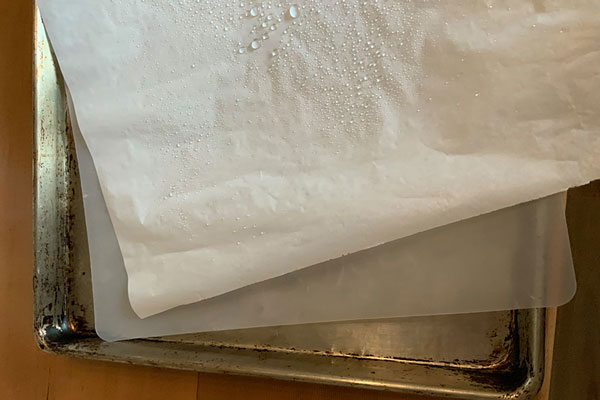Ingredients
- 100 g active sourdough starter (approx. ¾ c)
- 100 g yogurt and 150 g filtered water (or 250 g water)
- 394 grams bread flour* (approx. 3 1/8 c)
- 8 grams kosher salt
- rice flour for bread form/proofing basket (brotform, banneton) and dusting
Equipment
- 1 10-inch banneton or 10-inch bowl lined with parchment or linen cloth
- lame or slashing tool (scissors work, or some type of razor tool with a long blade)
- parchment paper (14 sq. in.)
- baking sheet as a tool that provides support for transfer of the loaf to the cooking vessel
- support sheet: a large (about 14 in.) light, flexible plastic or cardboard sheet to support dampened parchment paper; see step 13.
- water mister
- aluminum foil and
- baking vessel: baking stone, cast-iron pan, or Dutch oven with a lid
Directions
- Measure starter into a bowl.
- Add yogurt (opt.), water, bread flour, then salt. I place salt on top of the flour instead of directly onto the starter/yeast.
- Mix until ingredients are well blended into a very sticky dough. Cover with aluminum foil***; let rest 4 hours at 70–75 degrees F (22 degrees C).
- Fold and Bloom: With wet hands, fold dough—grab and lift dough over on itself—rotate about 90 degrees, and repeat 2 or 3 times. Cover with aluminum foil*** and allow the dough to ferment for 30 min.
- Repeat the Fold-and-Bloom step, three times, for 2 more hours.
- Prep the banneton or prepare the proofing bowl: mist lightly, then dust with rice flour; dry thoroughly before using.
- After the final 30 min. bloom of step 5, scrape dough onto work surface that is lightly floured with either bread flour or all-purpose flour. Shape into a ball with a smooth, unbroken surface** by pulling edges into center and turning the loaf. Pinch together rough surface edges towards the center to smooth them out and to maintain the round ball shape. Use flour to keep it from sticking. Transfer smooth-side down to prepared banneton.
- Cover and refrigerate 12 hours to slow the fermentation process.
- Remove loaf from the refrigerator and let it rise in a warm spot until the dough springs slowly back and retains a slight indentation when poked gently with a finger, about 3–5 hours.
- Prepare oven racks. On bottom rack, place water pan that will steam and provide moist heat. Place the baking vessel on a center rack to pre-heat. Preheat oven to 500 degrees F (260 degrees C).
- Wait until the oven is hot before the next step.
- Place a large piece of parchment paper on a support sheet on a baking sheet. Mist lightly to dampen the parchment paper..
- This step describes inverting the proofed dough in the banneton onto dampened parchment paper to minimize disturbance to the dough:
- Lift the support sheet with the dampened parchment paper over to the banneton containing the proofed dough; flip and place the dampened parchment paper and support sheet on top of the proofed dough.
- Lift the banneton with the paper and support sheet over to the baking sheet.
- To prevent the dough from falling out of the banneton and to minimize disturbing the dough, place one hand on top of the support sheet and your other hand underneath the banneton and invert.
- Lower all onto the baking sheet, slipping your bottom hand out as you carefully place the inverted bowl, parchment, and support sheet onto the baking sheet.
- Lift and remove the banneton, leaving the shaped proofed dough on top of the dampened parchment paper and support and baking sheets.
- Mist the top of the dough; using the sifter or sieve, dust the surface of the dough with rice flour; gently brush off excess.
- Score top of the dough. Create a design of your choosing. Simpler is better.
- Mist entire surface lightly with water.
- Carry the baking sheet with the parchment paper and prepared dough close to the oven. Open the oven; using the diagonal corners of the parchment paper as handles, lift and carefully transfer the parchment paper with the dough onto/into the baking vessel.
- Encase the baking vessel with aluminum foil*** or Dutch oven lid. Close oven.
- Turn oven down to 450 degrees F (230 degrees C). Bake for 20 minutes.
- Take cover off and bake for approximately 10–15 more minutes. Use a thermometer to check internal temperature of the bread. (195–210 degrees F) before deciding to remove it from the oven.
- Transfer to a cooling rack; cool the bread before slicing.
Cookie Sheet
*Some people have had success with all-purpose flour.
**When folding, I imagine that I am creating an elastic balloon case over the dough which will trap gases; the pinching action much like pinching the neck of the balloon that will keep the trapped gases inside and allow the dough to expand similarly to a balloon expanding when we blow into it. As the gluten strengthens over time, the overall shape will hold in the oven instead of the loaf spreading and expanding horizontally, flattening like a deflated balloon.
***I use the same aluminum foil used in steps 3, 4, and 18. My fermenting bowl and proofing basket are the same size and since the size of the baking loaf is the same size as the the proofing basket, the foil covering is shaped to fit perfectly over the baking loaf.



